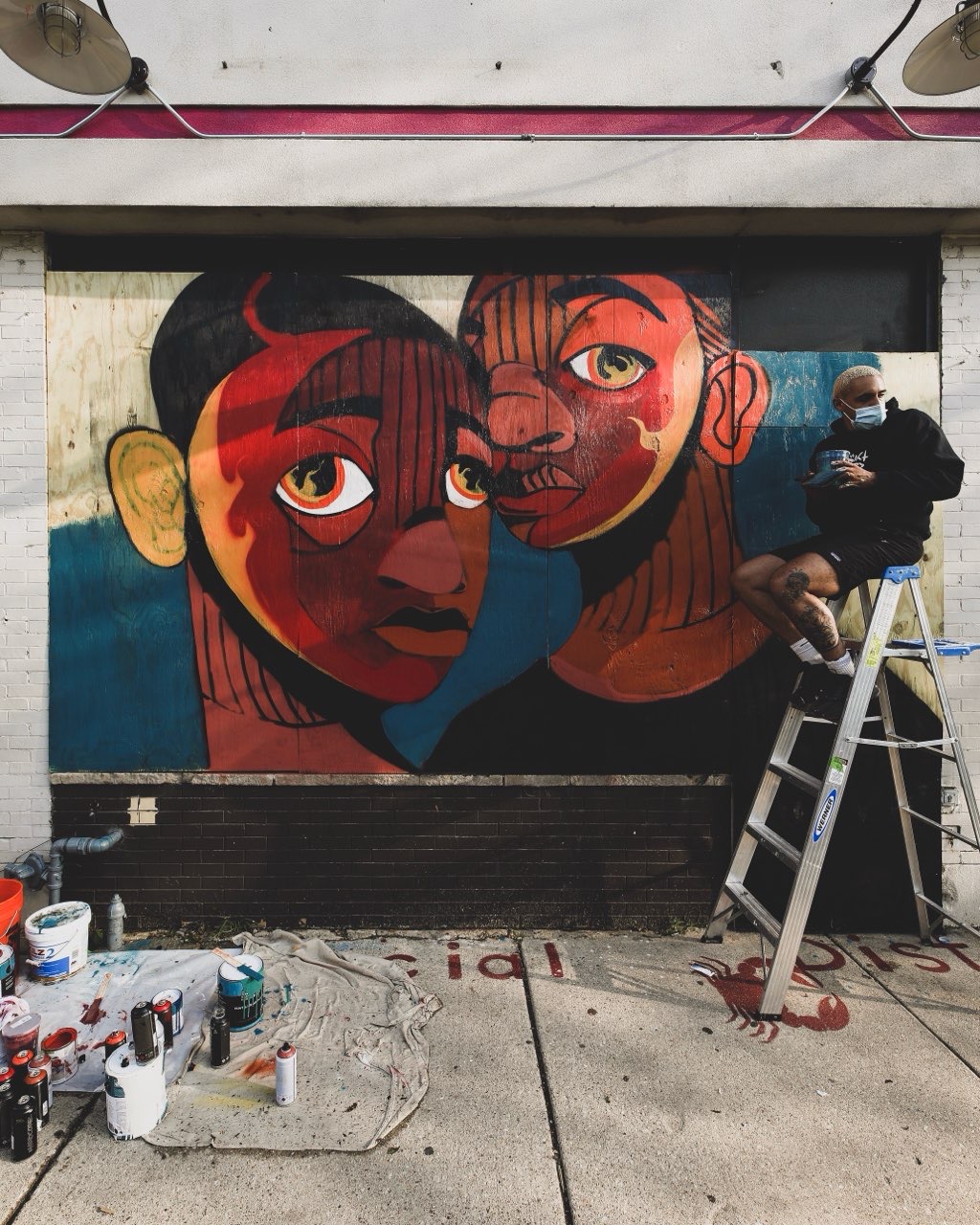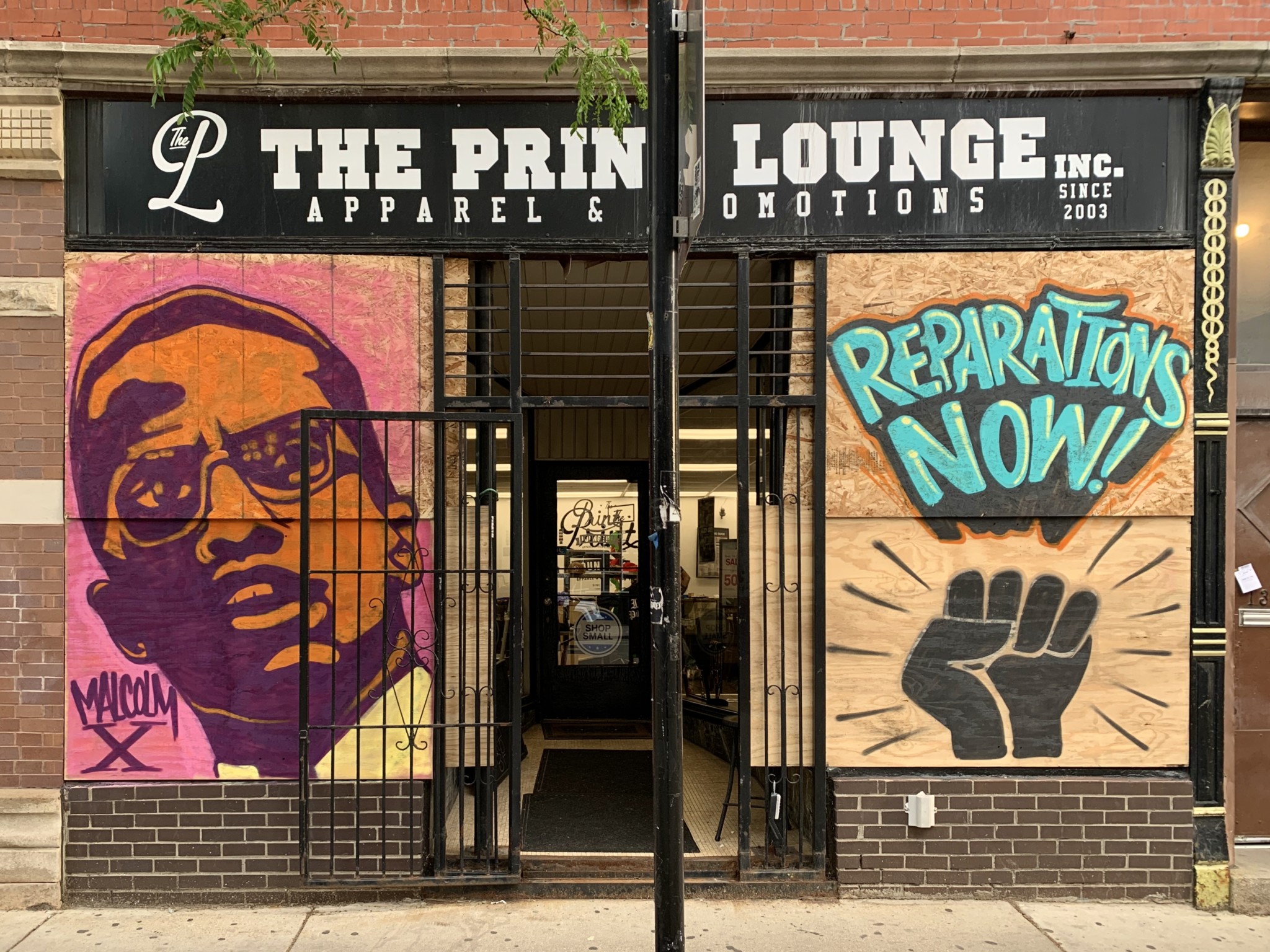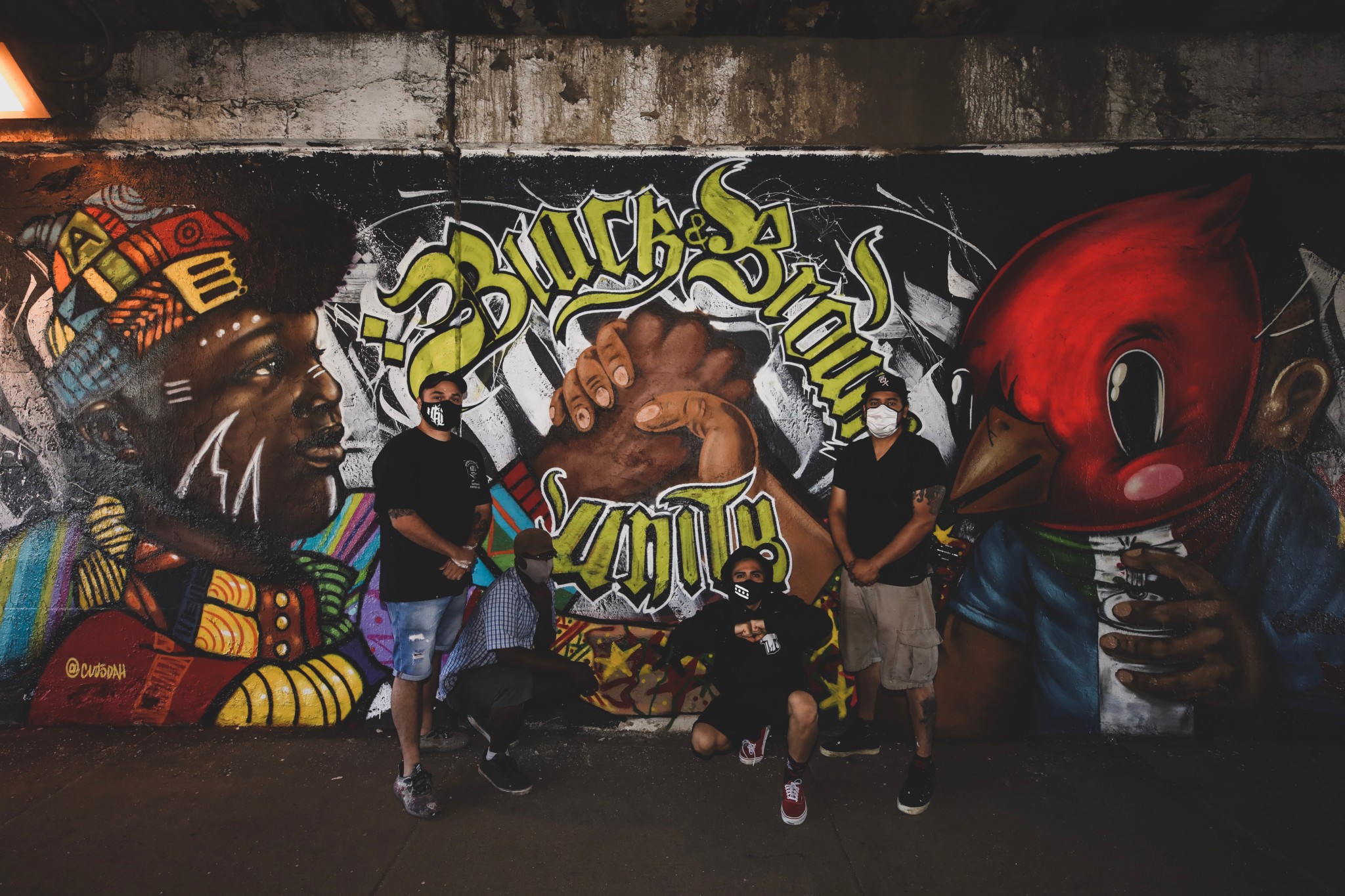As the evening sky above Pilsen went from light blue to Pantone Ultra Violet on June 1, small business owners sat scattered along the sidewalks, prepared for whatever the night might hold.
The night marked one week of protests that have drawn thousands around the country, mourning and demanding justice for George Floyd, Ahmaud Arbery, and Breonna Taylor. While most protests in the Chicago area remained peaceful, on May 30 and June 1 many Chicago neighborhoods saw often-unrelated looting and destruction, causing worry for many small business owners.
Earlier that day, Delilah Martinez, owner of Vault Gallerie, was at the fitness studio Healthy Hood on South Damen Avenue and West 22nd Place, wrapping up a community initiative, when she received a call from her friend Mario Maldonado, owner of the local print shop Chicago Midwest Made.
Maldonado planned to spend the entire night staking out 18th Street alongside residents, other business owners, elderly neighbors, local gang members, and police to guard against possible looting. Minutes before the call, he mulled the dilemma many shop owners faced that night: to board or not to board.
In the end, Maldonado reluctantly installed dull plywood over his windows. But then, looking up at his boarded-up storefront, he saw an opportunity. The clean plywood was the perfect canvas for artwork delivering a social message, and he knew Martinez could make it happen.
A three-minute phone call between Martinez and Maldonado became the catalyst for a widespread art initiative showing how Black and brown communities could protect and uplift their own neighborhoods without the involvement of law enforcement or local government.
In the next hour, Martinez worked fast to bring Maldonado’s vision to life. She reached out to artists Frillz, Fire Falco, and Clue, who agreed to paint the mural on Maldonado’s boarded-up windows free of charge. She picked them up in Little Village, collected supplies donated by another artist, Sentrock, and made it to Maldonado’s store by 6pm.
Maldonado supplied the artists with food and a ride home. The mural was finished in a few hours and everyone frantically rushed through clean-up to make it home by the citywide 9pm curfew.
“It’s literally like we are in a war zone,” said Martinez. “It’s a ‘hurry before the sun comes down’ type of feeling.”
The next morning, Instagram was flooded with images of the mural adorned with the message “United we stand, divided we fall,” accompanied by a heart holding the words “Black Lives Matter.”
[Get the Weekly in your mailbox. Subscribe to the print edition today.]
By the end of the day, one mural became eight. Seven days later, there were thirty-two murals by more than thirty local artists dispersed throughout Chicago neighborhoods, including Boystown, Bronzeville, Auburn Gresham, Logan Square, Back of the Yards, and all the way west to North Riverside.
Word even spread to Indiana, where business owners were contacting Martinez asking for art on their storefront plywood.

“When everything happened with George Floyd and we started protesting, I wanted to get the message of Black and brown unity out there,” explained Martinez. “I was taken aback and very saddened by the turn of events when people were really trying to divide us.”
Martinez was referring to the reports and footage circulating on social media of anti-Black harassment and violence in Little Village and Pilsen. The attacks were allegedly instigated by non-Black Latinx community members in Little Village, Cicero, and Pilsen. “I have a lot of African-American friends who did not want to come to the community because they were scared,” she said. “I just wanted to let everybody know that [Pilsen] is a safe place.”
Black love, brown pride
Five blocks east of Maldonado’s shop is The Print Lounge, an apparel printing shop. After the death of George Floyd, owner Imanuel Basley decorated his storefront with T-shirts calling for reparations, the abolishment of ICE, and a shirt that read “R.I.P. BIG GEORGE.”
Basley’s shop is one of the only Black-owned businesses on the 18th Street strip. When the opportunity arose to have artwork done on his boards, he decided to stick to the same messages that adorn his shirts.
Martinez arranged for two artists to bring Basley’s message to life. Basley initially envisioned a portrait of Martin Luther King Jr., but when the artists brought him the sketch of Malcolm X, he agreed.
Basley explained that “Reparations Now,” coupled with a portrait of Malcolm X, felt like a bold statement. “Am I a little fearful? Or was I hesitant? No. Because it’s up there. I felt that one thing I could do was make a statement with the little space that I do have.”

Martinez collaborated with artists Brenda “Kozmo” Lopez and her husband, MATR, to create Basley’s storefront artwork.
“I’ve gotten a good response on social media,” said Basley. “I heard that when they were doing the piece, somebody rolled by and was like, ‘Malcolm didn’t stand for peace,’ but I have had a lot of people come by and take pictures.”
Basley said that despite obvious differences in their histories, the source of the racial injustices faced by African Americans and Latinx people is the same. He urged the two communities to join forces, stating that they are more powerful together.
Nelly Hernandez, a Little Village resident and special education teacher, came by Basley’s shop after seeing his “Black Lives Matter Ally” T-shirts on Twitter. “I think this is our opportunity to be out there to support those who need us, and vice versa, she said. “Black and brown unity, that’s what the message is.”
Elias Morales, a lifelong Little Village native, echoed Hernandez’s sentiments. “Although I will never understand what it means to be Black, I also have been victimized by police,” he said. “We’ll take over the world if blacks and Latinos [come] together.”
This is just what Martinez hopes her efforts will lead to.
Symone Snowden-Wright, a stylist and local community activist involved with the mural initiative, remembers growing up on the South Side and seeing little art in her neighborhood.
She reflected on commuting over an hour via bus and train from West Pullman to her Lincoln Park private school every day. The dilapidated buildings and aging murals would turn to pristine exteriors, covered in vibrant, well-maintained art. After seeing Martinez’s Instagram posts about the mural project, Wright reached out to her about taking the initiative all the way down to East 79th Street and South Cottage Grove Avenue.
“I think 79th Street is the embodiment that … a community that is just completely overlooked,” Wright explained. “Seeing yourself in a piece of artwork every day is really important and it gives you pride about your neighborhood.”
Driving through parts of the South Side, Martinez noticed what Wright described. “I want to find permanent walls for murals [at local businesses] so we can add value to their community.”
Three days after painting Maldonado’s mural, Martinez arranged for artists Hailey Losselyong, Oscar Joyo, Just Fanny, and Megan Kind to paint a mural reading “Black is beautiful” on Star 6 Beauty Supply at 7856 S. Cottage Grove. “To now see art in my neighborhood, knowing how many times my granny stood waiting for the buses on 79th and now has something beautiful to look at has moved me to tears,” said Snowden-Wright. “I can’t wait to get big amazing murals in West Pullman and South Shore.”
Black and brown unity, whited out
On the night of June 6, artists Sentrock, Rahmaan Statik, Tubsz, Nikko Washington, Dred Ske, Milton Coronado, Rico, and Cujo Dah wrapped up a sixty-foot-long mural in an underpass on the edge of West Town. The underpass had months earlier been approved by 27th Ward alderman Walter Burnett for a different mural project that was derailed by COVID-19; this new mural showed two hands, both different shades of brown, clenched in unity. The hands were surrounded by the phrase, “Black & Brown unity” written in detailed lime green graffiti lettering. Alongside the expansive mural, the group painted a smiling Breonna Taylor with a golden halo atop her head.

As the artists ended their long labor of love, they shared photos and videos of the intricate murals across their social media platforms, with no idea of what awaited them the following morning. At 7:30am, a photographer contracted by Martinez found the murals covered in a slapdash layer of white paint.
“It’s almost like something died in my heart,” said Delilah Martinez about the vandalism, a tear running down her cheek. “I work so hard for all these things and I’m just sick of being bullied.”
The following afternoon, the crew of artists and organizers gathered at the wall. The only clues as to what had happened were two five-gallon containers of paint—one white Loxon brand primer and an untouched bucket of black paint—and a half-full tray with the head of a roller stuck inside of it. Burnett’s office said the whitewashing was not authorized by them, and Union Pacific—which owns the viaduct jointly with Metra—said the railway did not do it either.
Tubsz, who curated the team that worked on the mural, said he was “frustrated, sad, and angry. …We’re sending a message of love and unity for Chicago. And what are they sending a message of? Hate.”
Many of those involved with the mural initiative believe that people are threatened by the power of Black and brown solidarity. “To me, this is a hate crime,” said Maldonado. “You went out your way to purchase [paint] to cover up something positive because you don’t want to see us unite.”
Martinez says that if the artists charged their regular rates, the mural would have gone for upwards of $20,000. Now that it has been vandalized, the group does not plan to repaint it. Instead, they will recreate the mural somewhere they say it will be appreciated.
“We are hit with so much hurt but it fuels our fire,” said Martinez.
An initiative for and by the community
Despite the hurt the vandalism caused, Martinez is not deterred.
Like many others, the gallery owner feels the strain that the COVID-19 pandemic has put on her business and personal finances. “I’ve been broke as hell,” she said. “[My gallery] has been shut down since March.”
Martinez said that all of the artists involved are in a similar financial situation, but support from the community has poured in. “Now we’re getting an abundance of food and an abundance of love and it’s just amazing,” Martinez said. “We really don’t need politicians and people to run our communities, we can run our own communities.”
All of the resources needed for the initiative have been funded and supplied solely by individuals and businesses. As soon as the artists pop up in front of a shop, local restaurants and cafes rush to provide food and supplies.
On Instagram, Martinez along with Wright and other organizers, called upon followers to donate funds for the artists and supplies via Venmo. In twenty-four hours, donations surpassed $5,000, and by the evening of June 6 that total neared $9,000.
A cry for solidarity
In Pilsen on June 3, Jeff Pak, Bird Milk, Joey D, and Reddo painted their respective graffiti characters sharing a common message bubble of “Black Lives Matter” on a storefront across from Maldonado’s shop. Hours later, the trio had to cover up the message and change it to “unity” at the shop owner’s request.
“I get upset because there’s no reason not to say [Black Lives Matter],” said Pak. Another business in North Riverside, where Pak painted a mural, also decided against covering their storefront with the message, he said.
That night a Pilsen march for Black and brown solidarity drew thousands of residents. Protesters carried signs that held messages of Black empowerment and brown solidarity. Speakers urged the predominantly non-Black Latinx crowd to stand side-by-side with their “Black brothers and sisters,” while the protesters joined together peacefully in songs and chants.
The march that followed was led by Nivea Sandoval, seven, and Tia James, five, who clenched hands for almost the entire procession. Behind them was a sign that read “BROWN PEOPLE FOR BLACK POWER.”
Moments before the march began, three city buses full of police officers in riot gear arrived. “They came pushing their way in with their cars, sideswiping people in the protest and getting everybody riled up,” said Martinez.
While Soul and Wellness Medical Marijuana Services and Education, located a few doors from Martinez’s gallery, was being attacked by armed looters, she watched in horror.
“There were like twenty, thirty people with weapons coming and busting into the store. We tried to call the police,” said Martinez. “They did not answer.”
Martinez expressed frustration regarding the over-policing of peaceful protests in Pilsen compared to the lack of support available during reported looting. “I had a moment yesterday where I thought to myself, we don’t need anybody, we can do this on our own,” she said.
Inside his 18th Street shop, Basley choked back tears as he reflected on the bittersweet progress African Americans have made. “To see people like Michael Jordan and Kareem Abdul Jabbar, who have reached the highest level of human capability, and to still be looked at as three-fifths of a person is very hurtful,” he said. “Individually, we continue to reach those milestones and break all kinds of ceilings, but collectively, we have a lot of work to do.”
Basley was referring to the Three-Fifths Compromise, the 1787 law that equated each enslaved person to three-fifths of a person when calculating the population for legislative representation. Although the Compromise was repealed in 1868—three years after slavery was abolished—Black people continue to be dehumanized by political and social systems in place to this day.
Basley reflected on the aftermath of the murder of Trayvon Martin and hopes that this time around, protests and public action lead to real, lasting change. “We try to put Band-Aids on huge wounds and in this particular case, we need a cast, ” he said. “We need to repair the broken bone and a Band-Aid can’t do that.”
Buried under countless unread emails of support and requests in Martinez’s inbox was an email from the Obama Foundation. Martinez hopes to collaborate with the organization in the near future as the mural initiative continues to grow.
“This has been literally the most depressing, rewarding, loving, happy time of my life … and it all really sparked with George Floyd,” said Martinez. “I just want Black and brown people to understand that the art culture loves with no limits. We have their back.”
Wright feels the mural initiative will communicate just that.
“Chicago is one of the most segregated cities in the United States,” she said. “When you divide people physically, it’s so much easier to divide them mentally.”
“[We’ve] been waiting for most of our lives, our parents’ lives, our grandparents’ lives, for people to show up for us,” said Wright. “And it has become quite evident that we have to show up for ourselves.”
Martinez has launched a GoFundMe campaign to raise money for more murals; so far it has raised almost $12,000.
Neena Rouhani is an Iranian-American writer from the east side of Detroit. She is currently working towards her master’s in journalism at Medill. Her work focuses on music, art, culture, and race. This is her first story for the Weekly.
